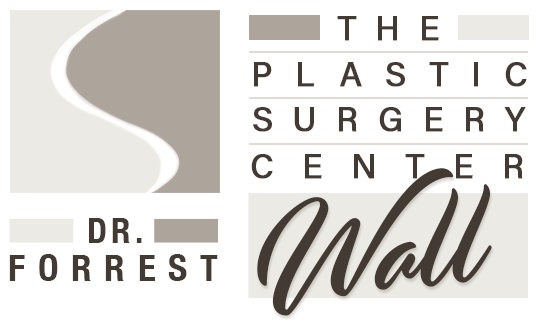Can you breastfeed with breast implants? This is one of the most asked questions we receive from those looking to get breast implants. We’ve got great news! Most women can still breastfeed after an augmentation. As long as the breast augmentation surgery doesn’t involve the areas of your breast involved in the milk production process, implants should not hinder you whatsoever.

Can You Breastfeed With Breast Implants?
The most important factor in determining if you’ll be able to breastfeed after a Shreveport breast augmentation surgery lies in the hands of your plastic surgeon. If breastfeeding is an option you want to keep open, let Dr. Wall know. He will discuss the various routes you can take in order to have breastfeeding success, down the road.
Breastfeeding With Implants
If you’ve already had a breast augmentation and are wondering if you can breastfeed with implants, you’ll have to ask yourself the following questions:
Where Were Your Incisions Made?
Several techniques exist for inserting a breast implant. Five of the most common include:
- Under the breast
- In the armpit
- Around the nipple
- Inside the belly button
- Through the abdomen
Under the breast is currently the most popular technique for breast implant surgery. Using this method, the scar may not be visible when the incision is in the inflammatory fold or crease–where your breast meets your chest wall.
The position of the incision and the plastic surgeon’s technique used to insert your breast implant will affect how much damage is done to the nerves, ducts, milk glands, and overall blood supply to your breast.
If your incisions were made across the areola or your nipples, more than likely, your milk ducts and nerves were cut during your breast augmentation. In this case, breastfeeding might not be an option for you.
However, more than likely, your incisions were made either underneath your breasts or closer to your armpits. In this case, your breast augmentation should not hinder you from producing milk effectively.
Do You Still Have Feeling in Your Nipples?
The 4th intercostal nerve is the main nerve that provides sensation to your nipple and areola. When this nerve is stimulated, it triggers the release of oxytocin (your breastfeeding hormone) and prolactin from your brain. Any damage done to this nerve could certainly affect the ability to breastfeed.
If you still have sensation in your nipples after your breast augmentation, that’s generally a good sign that your nerves are working correctly. However, if your breast augmentation surgery was less than a year ago, the sensation may not have returned to the area yet. So, no need to panic. You still have the option to breastfeed, in this case, too!

Where are your Breast Implants Located?
The breast implant placement will also affect whether or not you’ll be able to breastfeed after an augmentation.
If your breast implants are located under your chest muscle, you’ll have a better shot at success in breastfeeding.
If your breast implants are right under the glandular tissue of your breast, thus on top of your chest muscle, this can sometimes interfere with milk production.
However, most plastic surgeons opt for the first. So, if you’re unsure and you’ve had a breast augmentation fairly recently, chances are that they’re under the chest muscle. Contact your plastic surgeon for more information if you’re unsure.
What Were Your Reasons for Getting a Breast Augmentation?
Your body produces milk inside of your breast through glandular tissue. Then, fine ducts or tubes carry the milk to the nipple. Any cuts or damages to these ducts or glandular tissue will interrupt the exit route for breast milk.
A greater risk arises if your breasts require the plastic surgeon to remodel or lift them, along with your breast implants.
If you elected to have breast augmentation surgery simply because your breasts were small or for other cosmetic reasons, you’re probably a good candidate for breastfeeding after a breast augmentation.
However, some women choose to get breast implants because the breast tissue never developed, their breasts are spaced far apart, or they are tubular in shape or asymmetrical.
If any of these reasons describe your situation, it is possible that you may not have enough glandular tissue required to make milk. In such a situation, breastfeeding difficulties would be attributed to the underlying issue of functional breast tissue absence, as opposed to your breast augmentation surgery itself.
Did You Have Complications?
Breast implants are not meant to be lifetime devices. They will often require corrective surgeries over time.
Shreveport breast revision surgery or complications can cause damage to the breast tissue. This may hinder your ability to successfully breastfeed after a breast augmentation.
Complications can include:
- capsular contracture (for surgeries over ten years ago),
- surgical removal of scar tissue,
- changing the implant type, size, or location.
Also, repeats of the breast lift procedure may also hinder breastfeeding after an augmentation.

Shreveport Breast Augmentation for Moms
If you’re considering a Shreveport breast augmentation procedure and are planning to breastfeed in the future, you can rest assured that both silicone and saline implants are safe for breastfeeding if done correctly.
When you consult with Dr. Forrest Wall about your breast augmentation surgery, you will discuss the incision type he will use for the procedure.
Reach out to us at 318-221-1629 if you have any questions or to schedule an appointment.

